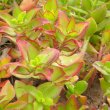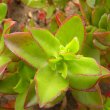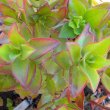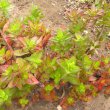| Botanical Name |
Crassula sarmentosa ssp. sarmentosa |
| Family |
Crassulaceae - The crassula family. |
| Pronunciation |
KRASS-oo-la sar-men-TOH-suh |
| Common Name(s) |
|
| Plant Group |
- Succulent A plant having fleshy stems or leaves often adapted to dry conditions.
|
| Plant Size |
- Small to Medium
| Tree | 8m to 15m |
| Shrub | 75cm to 1m |
| Perennial/ground cover | 20cm to 40cm |
| Bulb | 30cm to 40cm |
| Succulent | 20cm to 40cm |
|
| Position |
- Dry Shade Shady areas where soil has poor water retention or are dependent on rain for their moisture needs.
- Partial Shade The area is in shade for part of the day and in full sun for part of the day.
- Sun The area is in full sun for all or most of the day, all year round.
|
| General Information |
- Drought Tolerance: High The plant is well adapted to arid conditions; it can survive long periods of drought and high temperatures without extra water.
- Evergreen Plants that have leaves all year round.
- Frost: Half-hardy The plant is able to survive low temperatures and some frost but requires protection against severe frost.
- Sand tolerant Plants adapted to survive in nutrient poor, very sandy soils.
- Water Wise Plant species originating from low rainfall regions that require less water to survive and thrive than other plant species.
|
| Specific Information |
Crassula sarmentosa ssp. sarmentosa forms a neat, rounded, sub-shrub with slightly toothed succulent leaves. While the leaves are dark green if grown in shade, the plant becomes highly ornamental in dry, sunny conditions, the leaves turning to an almost neon green blending to pink and yellow, with dark red margins. They make an extremely decorative ground cover or feature plant. In their natural habitat they are able to withstand drought although they are unlikely to look their best after long periods without moisture. They produce large masses flowers and can tolerate year-round or summer rainfall conditions.
|
| Ad Break |
|
| Flowers |
| Description |
tiny, star-shaped flowers in dense, branched heads.
|
| Season |
- Summer to Autumn Plants will seldom bloom for the entire season as given in the list, but should flower during a period within these parameters.
|
| Colour |
|
| Growth Rate |
- Moderate to Fast Specifying growth rate can be very misleading as there is considerable variation of growth rate depending on type and species of plant, available water, supplementary feeding, mulching and general care, as well as the plants suitability and adaptability to the garden environment.
|
| Plant Uses |
- Attracts bees, butterflies or other insects This plant attracts insects which can be food for birds or other creatures in your garden.
- Border A strip of ground, at the edge of a driveway or path in which ornamental plants or shrubs are planted.
- Container Trees, shrubs and ornamental species that can adapt to growing in a restricted environment.
- Edging A low growing plant that provides softness or definition to the edges of a bed or walkway.
- Filler Either a fast growing tree or shrub used temporarily to fill in an area while the permanent plants grow to a desired size, or a plant used to fill gaps in borders or beds.
- Ground Cover Low-lying plants that spread fast, require minimal maintenance, and cover large expanses or bare areas between bulbs or shrubs. They provide protection from erosion and drought and improve the visual appearance of the garden.
- Interplanting Arranging and planting plants in the garden that have different blooming times and habits of growth, extending the amount of time in which the area is in flower.
- Pot Plant A plant that needs a protected environment on a patio or indoors.
- Rock Garden An area constructed of larger rocks, arranged naturally, to emphasise the use of stones as a main element. Generally plants used do not need a lot of care.
- Suitable for coastal gardens Plants adapted to dry, sandy soil, forceful wind, limited rainfall and intense sunlight.
|
| Distribution and Habitat |
along the eastern coastal belt from Knysna in the Eastern Cape, spreading to central KwaZulu-Natal, in fynbos, semi-arid scrub and Savanna grasslands, on rock faces or in ravines
|
| Planting Suggestions |
Plant in full sun, very light shade or semi-shade, depending on the desired leaf-colour, in any well drained soil. Most easily propagated from cuttings which can be planted directly into the ground as long as they get a little water until they root. Water occasionally until established, after which they can be treated as water wise. Tip off the smallest pair of leaves from each stem while quite young and again as stems begin to lengthen, to encourage denser growth.
|
| Lorraine's Garden Notes |
In full sun conditions I do put a layer of grassy mulch around this succulent to retain moisture, but only water them when critically dry.
|
| Medicinal Uses |
|
| Ad Break |
|








Discuss this plant
Share knowledge, ask a question or give an experience.